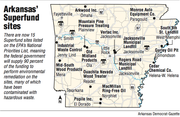Federal administrators announced Thursday that another hazardous-waste site in Arkansas has been added to the national list of Superfund sites eligible to receive federal cleanup funding.
The U.S. Environmental Protection Agency Region 6, headquartered in Dallas, has added the former MacMillan Ring Free Oil refinery site -- also known as Norphlet Chemical Inc. -- to the National Priorities List. The list identifies abandoned industrial sites thought to be most in need of immediate cleanup because they pose contamination risks to area water, soil or air. There are 15 sites on the list.
The refinery is in Norphlet, about 8 miles north of El Dorado in Union County. After MacMillan ceased operations at the site in 1987, the property traded hands several times and was used for industrial manufacturing involving the production or use of hazardous materials. The record of interventions by the EPA and the Arkansas Department of Environmental Quality stretches back to 1990, when an emergency order was issued for removal of asbestos there.
In 2010, the Environmental Quality Department placed the site on the State Priority List. Tammie Hynum, chief of the department's hazardous-waste division, said the abandoned industrial sites are placed on the list if they require hazardous-waste cleanup and no viable entity can be found to take responsibility for it.
Hynum said the costs associated with cleanup and decontamination at such sites are paid for through the Arkansas Remedial Action Trust Fund Act. That trust fund is funded with enforcement fines issued by the department, as well as inspection and monitoring fees, Hynum said. As of May 1, the trust fund has about $8.9 million in it, Hynum said.
Adding a hazardous site to the State Priority List requires Environmental Quality Department staff members to propose "rulemaking" to the Arkansas Pollution Control and Ecology Commission under Regulation 30, which governs the use of the remediation trust fund.
When the cost of cleanup at a site exceeds what the state can reasonably manage through the trust fund, department administrators appeal to the EPA through a lengthy assessment and review process to move the site to the National Priorities List, Hynum said. Once on the national list, the EPA covers 90 percent of the cost of cleanup operations until a site is in "post-closure" status, when the state is again responsible for all costs associated with monitoring and maintaining the site.
Funding for the National Priorities List was established through the Comprehensive Environmental Response, Compensation, and Liability Act of 1980.
There are 14 sites throughout Arkansas on the State Priority List. The former refinery in Norphlet is the second Superfund site in Union County currently on the National Priorities List. Popile Inc. in El Dorado was added to the national list in 1992, after the EPA began removing contaminants associated with wood treatments from the surrounding soil.
Union County, and El Dorado in particular, have about 60 industrial sites that hold hazardous-waste permits issued by the Environmental Quality Department. Three of the state's 17 "treatment, storage and disposal" facilities -- those permitted to hold hazardous wastes for more than 90 days -- are in El Dorado.
Lori Simmons, chief of environmental epidemiology at the Arkansas Department of Health, said the Health Department works closely with the Environmental Quality Department and the EPA in providing community health assessments for Superfund sites on the National Priorities List. Also, the Health Department is often involved in assessments of sites on the State Priority List, typically at the Environmental Quality Department's request.
Regarding public health concerns tied to the Superfund sites, Simmons said there are no data indicating the presence of disease clusters, either cancerous or noncancerous, or suggesting the presence of disease connected to any of the sites in Arkansas.
Shirley Louie, epidemiology branch chief at the Health Department, said cancer data are collected through the Arkansas Cancer Registry, and medical providers throughout the state are required by law to report instances of many diseases to the Health Department.
Anyone interested in learning about contaminated sites in a particular area can consult the Environmental Quality Department's list of hazardous cleanup sites on the National Priorities List and the State Priority List at www.adeq.state.ar.us/hazwaste/branch_tech/ratf.aspx and explore the Arkansas Cancer Registry at www.cancer-rates.info/ar/index.php.
Arkansas on 05/11/2014

